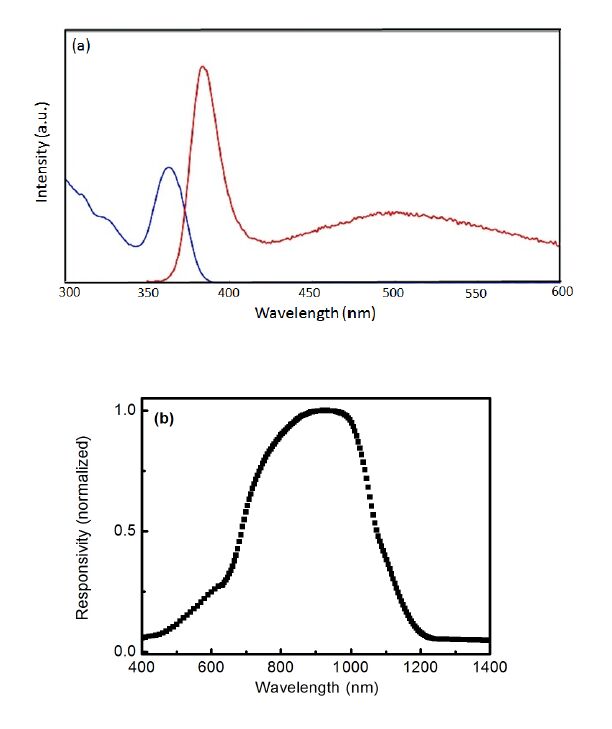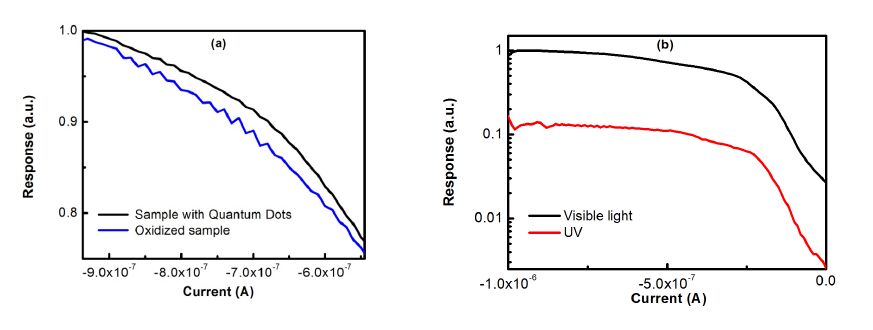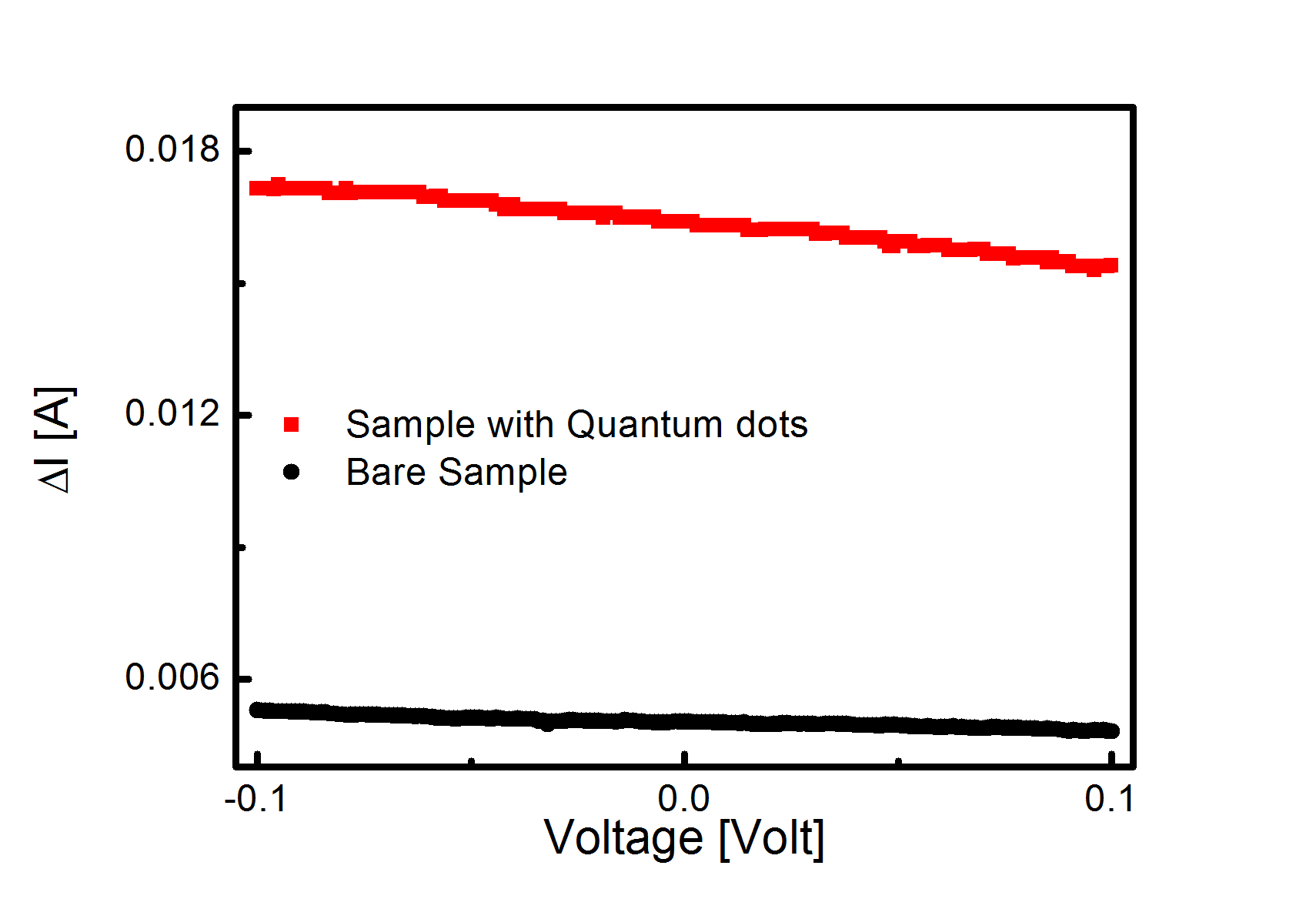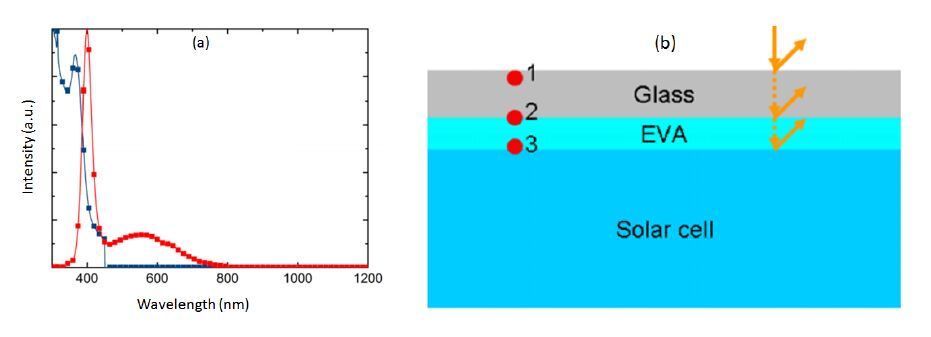1. Introduction
The world’s energy consumption, even with improved conservation measures, is projected to triple, reaching approximately 46 Terawatt (TW) by the end of this century. With regard to future energy needs, it is noteworthy that 1.2×105 TW is deposited on the surface of the earth by the sun, in a broad IR to UV spectrum. A main challenge revolves around conversion, storage and efficient use of this immense solar power source. Si based solar cells supply the most reliable, cheapest and most common solution for high efficiency solar cells [1]. It is therefore expected that solar cell farms will use some form of Si either as the active energy harvesting element, or as a substrate. Nevertheless today’s Si technology that generates electric power is still about 3 times more expensive than energy from fossil fuels. A substantial improvement in Si-based solar cell efficiency is therefore essential.
The fundamental limits of solar energy conversion efficiency were explored by Shockley and Queisser for a p-n junction [2]. For an idealized p-n 1.3 eV bandgap junction, 30% maximum theoretical efficiency is predicted. Realistically, the p-n junction solar cell is limited by losses from a variety of sources including carrier thermalization and recombination, contact and junction losses and transparency losses. To date, the highest efficiency of photovoltaic devices that has been fabricated is achieved by using multiple p-n junctions or tandem solar. The tandem cell efficiency record has recently exceeded 40% [3]. However the requirements of lattice parameter and current matching between the p-n junctions increase the cost of the single cell restricting the commercial use of these cells. In the presented work a simple and cheap multilayer coatings is added to existing solar cells improving the cell efficiency.
The photovoltaic (PV) industry is composed from variety of materials while the most common is silicon due to its low cost, abundance in nature and physical properties [4]. However, there are some losses occur due to parasitic absorption either in the glass, capsulatingmaterial or via free carrier absorption in a highly doped emitter, and after absorption due to recombination at the front surface or emitter. Moreover, surface recombination in conventional Si solar cell reduces cell efficiency in short wavelengths. Therefore, in many solar cells For the UV spectrum the total quantum efficiency drops dramatically, consequently significant percent of the sun light is not utilized. Additionally, the Si cells are usually coated with thin dielectric layers to prevent reflections from the solar cell surface, and to protect the cell [5,6,7]. These layers usually absorb in the UV reducing the total sun spectrum absorptions of the cell. One of the many ways to improve the efficiency of solar cells is down conversion. Theoretical estimation suggested that small yet significant improvement can be achieved using down conversion techniques [8,9,10]. Experimental studies were done using inorganic materials, nano structures and nano particles[11,12]. Due to the high stability of nano crystals (NCs), and tunable spectrum, NCs were used in many cases as light converter in the visible spectrum [13,14]. The UV absorbance of the NCs also protect the organic material coating the cell from long range damage and may enhance the cell life time.
In recent years the use of nano-based devices was expended greatly due to progress in fabrication and characterization techniques. Systems based on self-assembled organic molecules and NCs are significant part in this development. Self-assembly from a solution is a simple, fast, and provide a reproducible method for producing organized monolayers on top of existing devices [15,16]. The molecules linkers control the energy transfer and charge transfer between the NCs and the devices [17]. The NCs layers can supply the needed quantum band gaps to the system. Utilizing wet self-assembled methods to adsorb the NCs on the cell could induce controlled excitation to the device surface. The advantage of semiconductor NCs is the ability to control their quantum properties by designing their size, shape, composition and doping [18,19]. Using organic molecules and different self-assembled NCs multilayers on top of solar cell devices could broader the absorption spectrum range.
These features are significant using commercial extremely thin absorber (ETA) silicon and other materials for the solar cells [5,20]. The cells are usually encapsulated using thylene-vinyl acetate (EVA) in order to prevent reflection and protect the cells [5,6,7]. The EVA absorb in the UV while the response of the Si based solar cell depends strongly on the exiting spectrum spectrum [21,22]. Our straightforward procedure of adsorbing multilayer of NCs on top of the EVA of the cell increases the solar cell efficiency. We modify this spectrum using energy down-conversion layers based on the NCs ability to absorb UV photons and emit at the visible range. Best performance may be achieved tuning the NCs band gap. By ordering consecutive NCs layers using a simple wet chemistry method we showed an increase in the cells' efficiency of 1%. We ascribe this improvement to the reduction of surface recombination effects. Simple theoretical estimation taking the high energy photons of the solar spectrum and down-converting them to the visible range multiplying by the standard solar cells external efficiency result in similar efficiency improvement.
2. Materials and Methods
To fully control the NCslayers/solar cells efficiency enhancement we have both fabricated our own Si based solar cells and used commercial cells. We will start by presenting the results from our own simple solar cells. Using highly doped n-type Si wafers we implanted a P type top layer. The ion implantation of boron atoms induced a thin layerof positive charges with a carrier density of on top of the n-type silicon wafer. The solar cells were realized using standard photolithographic techniques. Schematics of our experimental device are shown in Figure 1a. We illuminated our devices by both UV (300-400 nm) and visible light (400-700 nm) mimicking sun light source. The response of the cells was compared with and without the colloidal NCs layers. All the electrical measurements were done using lock-in amplifier while the light signal was modulated, we measured the voltage while the current was applied constantly to the device [23,24]. To compare between different light sources with difference intensities, we normalized the measurements with the total intensity.
We used 2.9-4 nm CdS NCs (MKNano Corp.) to achieve the energy down conversion (see absorption and emission spectrum sat figure 2(a)). The CdS NCs were linked usingorganic monolayer to the Si surface applying a self-assembled procedure followed by references [25,26]. The organic molecules used are (3-Mercaptopropyl) triethoxysilane (MPS).Sample preparation was performed in three steps. First, the device is sonicated in hot acetone as well as hot ethanol solutions for 2 minutes each. In the second step the substrates were immersed into 1mM MPS molecules (the“linker”) in Dicyclohexyl solvent for 90 min and washed in sonication bath with toluene for 1 min. This process was repeated twice, however, in the second time the samples were immersed into the linker solution for 60 min. In the last step the samples were introduced into a toluene solution containing the CdS NCs for 4 h. The entire process was performed under nitrogen inert atmosphere.
The electrical measurements were performed using lock-in amplifier comparing between dark, solar spectrum and UV light. Each solar cell was measured before the NCs adsorption, after the NCs layers adsorption and lastly after a long time, having the NCs to oxidize.
3. Results
The main results compare the efficiency of the standard solar cells to that of the hybrid solar cell that includes the self-assembled CdS NCs layer adsorbed on top of solar cell surface. The High Resolution SEM (HR-SEM) images of the surface of the hybrid cell are presented in Figure 1b. Multiple adsorption cycles procedures helped in increasing the NCs density therefore increasing the device response [27]. We present here only the results obtained with 3 adsorption cycles. The external efficiency improvement of 0.5% was constructed both for the UV and for the full solar spectrum. Figure 2(b) presents our simple fabricated Si based device response spectrum without the NCs. This device UV quantum efficiency is less than 2% of the total quantum efficiency. In standard PN junctions different contact are used for the P and N side [28]. Here we used a simpler configuration which may lead to small Schottky behaviour. Thus, using better contacts our external quantum efficiency may be improved as the nano particles down convert the absorbed photons while Schottky response usually increase with photon energy. This is also true when using standard Si cells with 100% absorption efficiency unlike the lower absorption efficiency in our cell.
Since surface recombination effects could be changed by the surface passivation of the adsorbed organic layers we compare the response of the same solar cell with the organic layers and the NCs to the response after deliberate oxidation process of the NCs. Figures 3a present the response of the same cell before and after the oxidation of the NCs to the full solar spectrum. The measurements were taken for parameters of maximumefficiency of the solar cell. It is clear that the self-assembled layer improves the UV response by down converting UV photons of the solar spectrum by around 1%.
Another way to estimate the improvement is to measure the enhancement in the UV range (below 400 nm) and compare the response with the solar spectrum. Figure 3b presents the total response improvement when illuminating in the UV range as compare to the normalized full spectral spectrum of the cell. From this figure it follows that the total UV enhancement of the solar cell response with the NCs layers was around 8% as compare to 1-2% without the NCs coating. Since this wavelength range covers less than 10% of the photons absorb in the cell, the quantum efficiency enhancement can be estimated to be less than 0.8%. In previous works we show that adding additional layers of the NCs could probably improve this ratio but would increase the total coast of the coating [27,29].
To demonstrate that the same procedure can work on any device the organic and NCs layers were adsorbed on top of a commercial device. Figure 4 presents the commercial solar cell response under UV illumination with and without the NCs. Vos, Jsc and Fill Factor (FF) for bare sample: 5 mV, 3.3 mA/cm2 and 0.08; and with NCs sample: 10 mV, 6.03 mA/cm2 and 0.104. The response was calculated by subtracting the response from the dark current. It is clear that for the cell with the NCs the response when illuminating in the UV is four times larger. As before this translates to improvement of the total cell quantum efficiency of about 0.4%. As far as we know this commercial cell EDA was not optimized for UV response, rather the EVA was optimized for UV protection and longer operation time. We did not check if our layers protect the EVA and increase farther the cells operation time.
4. Theoretical Estimations
To support the experimental measurements simple theoretical estimations have been made. The following analysis is based on the properties of a typical multi-crystalline silicon solar cell. This solar cell was integrated into a module-like structure using EVA encapsulation and a front glass. The encapsulated solar cell shows an open circuit voltage of 620 mV, a short-circuit current density of 35.7 mA/cm2, and a fill-factor (FF) of 79%, resulting in an overall conversion efficiency of 17.5%. For the calculations the ASTM-G173 AM1.5G norm spectrum was used.
The analysis was based on experimentally determined data of the absorption in the glass and the EVA. A possible difference between the solar cell with the hybrid layers and without layers, could originate from the reflection at the interface between air and glass, and to a much lesser extent between to the reflection at the interfaces glass and EVA. Further loss mechanism, which was considered, is the escape cone of total internal reflection. Due to the isotropic emission of the down converter material, a certain fraction of light is lost through the front surface. This fraction depends on the refractive index of the used materials. For this analysis, a refractive index of 1.5 was assumed both for the glass and the EVA. For the rest of the analysis, only single, direct paths of the light trough the different media were considered. We have also assumed that the down converter does not change the reflection properties of the glass or the EVA.
The properties of the down converter that were used: absorption below 400 nm and emission from 440 nm up to 700 nm were taken from experiments (figure 5a), those properties were optimize for calculation. The provided absorption data was scaled such that in the considered wavelengths range a maximum absorption of 100% was reached. Furthermore, no absorption was assumed for wavelengths longer than 420 nm. Three different positions of the down converter material were investigated; the down converter is placed on the front surface of the glass, the down converter is placed on the rear surface of the glass and the down converter is placed directly on top of the solar cell (Figure 5b).
The first option where the down converter is placed on the glass is superior to the configuration where the down converter is placed on top of the solar cell. The reason is that the EVA absorbs most of the photons that could be absorbed by the down converter. The absorption of the glass, however, plays only a minor role, because the glass shows strong absorption only for few photons that are a fraction of the solar spectrum.
Based on the above assumptions the expected short-circuit current of a solar module, which was created by encapsulation of the solar cell with a front glass and EVAequipped with a down converter, the total improvement in quantum efficiency was calculated for the optimized configuration to have an improvement of 0.8%. In all the positions shown in figure 5b the uniform reemission of the NCs was taken into account. Adding random plasmonic antennas could enhance the adsorption and reduce the remission losses [29]. Rayleigh scattering below the NCs bandgap is very small and was neglected.
5. Conclusions
In summary, using self-assembled NCs we show improvement in efficiency of the lab fabricated Si solar cells and commercial solar cells by~1% under solar spectrum illuminations. We attribute this improvement to CdS energy down-conversion. Simple model estimation shows that for the solar cells the improvement based on our assumptions is expected to be around 0.8%. Moreover, in order to have the maximum enhancement it is preferable to incorporate the down converter material on the glass cover of the solar cell and not directly on the cell surface, to reduce the EVA absorption effect which has a crucial part in the efficiency utilization. The suggested layers also protect the EVA from the UV and may enhance the total operation time of the cells. The method is applicable for all types of solar cells, nevertheless to achieve high absorption efficiency many layers should be used which increase the method price and may not be beneficial for immediate industrial use.
Conflict of Interest
The authors declare that there is no conflict of interest regarding the publication of this manuscript.









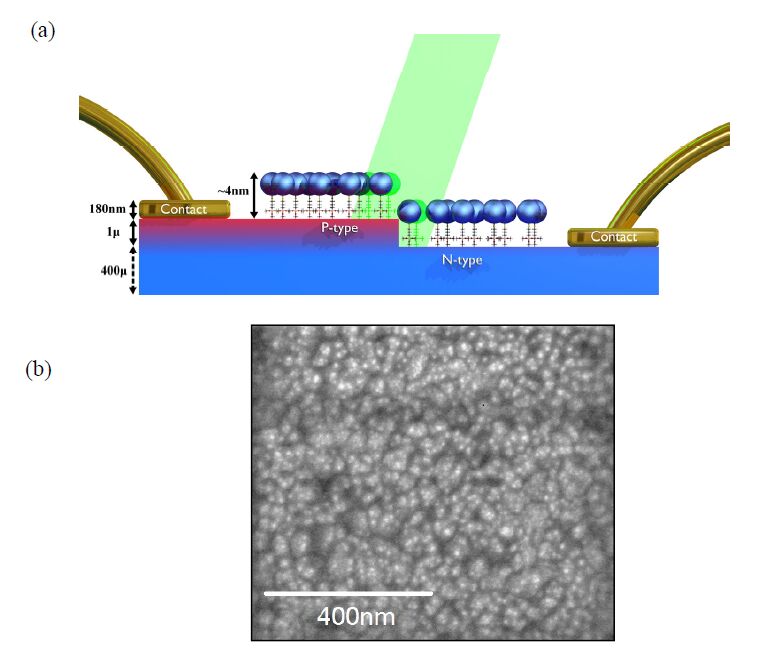
 DownLoad:
DownLoad: 